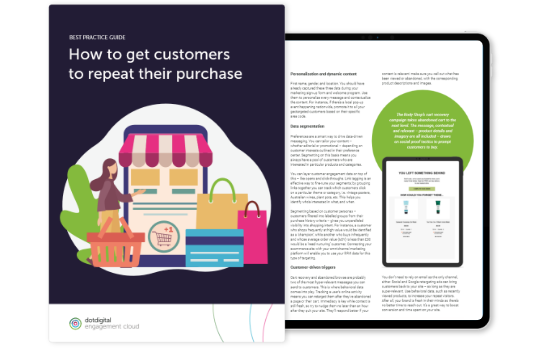6 ways to drive repeat purchases


Making this mistake, losing out on repeat purchases, can cost marketers big. Because it costs five times more to acquire a new customer than it does to retain an existing one. That’s why repeat purchase, and retention marketing in general, is an important strategy to pursue. It abates churn in the long run and helps grow your business through customer loyalty.
What is the repeat purchase rate?
It’s the number of customers who bought more than once (in the past 365 days) divided by the total number of customers during the same period. Keeping this rate high will do wonders for your bottom line, because repeat customers are nine times more likely to convert than first-timers.
What’s more, repeat purchase customers spend more on holidays like Black Friday and Cyber Monday. So, driving repeat purchases is even more essential for future revenue generation and business growth.
We’ve given you a sneak peek at our repeat purchase guide which goes through six key ways marketers can generate more repeat purchases. In this blog, we’ll give you a high level of each. To get your hands on the full insight, plus winning examples from brands, download the entire guide here.
1. Relevant messaging
After a customer places that first order, the bar is set for the next experience. Brands need to not just meet expectations, but excel where possible. Because a poor customer experience means they might not return at all; and that’s detrimental to your repeat purchase rate.
While ads might be your first inclination as a marketer, they can put customers off – unless they’re super-relevant. To avoid a potentially disruptive experience, where ads blend into whatever customers are reading online, marketers need the right data to hit the right messaging note.
What data do you need to be relevant across channels?
- Demographic information
- Behavioral insights
- Engagement data
- Purchase history
Remember, consumers – 63% in fact – are actually willing to hand over data in exchange for personalized experiences. All you need to do is ask for the right amount of data at the right time (i.e. at point of sign-up, and later in a welcome program through a preference center) to make your messages meaningful and relevant.
For more advice on personalization, segmentation, and triggered messaging, download our repeat purchase guide here.
2. Frictionless shopping
Customers want online shopping to be as simple as possible. So, it’s the job of marketers to create a customer-first experience where buying online regardless of the device is as easy, if not easier than, in store.
How can you remove friction from the online buying process?
Quick wins like guest checkout and flexible payment options are always popular with customers. Don’t forget auto-fill options and social media sign-ups, too. Remember, the customer experience is built on simplicity and ease.
If you want more insight on how to create a smooth online shopping experience, with tools like live chat and tactics such as social proof, download our repeat purchase guide here.
3. Valuable content creation
Much of your brand’s reputation online rests on the reliability, quality, and usefulness of the content you publish. The importance of good content is twofold: one, it makes your brand more credible and authoritative in your market; and two, it builds SEO value, so customers can find you when they’re in need of your products and services.
For repeat purchases, content adds immeasurable value to the customer journey. If customers are opted in to your marketing, make sure you’re sending them some first-rate editorial that enhances their experience.
Want more helpful tips on content? Find out how storytelling, how-to content, and relevant editorial can increase your repeat purchase rate.
4. Post-purchase perfection
In customer relationship terms, the aftersales journey is like the honeymoon period. Customers have just purchased from you, so you still need to dress to impress. Marketers should add as much value to this stage in the lifecycle – because it often makes the difference between the next purchase and lapsing. And remember, it costs much more to acquire a customer than retain one.
The aftersales journey is much more than just buying a product and having a great online shopping experience. The messages and content that follow can make or break the cycle, especially if the customer encounters any issues and is left feeling neglected. Showing customers you care about them and how they feel will go a long way.
Plus, optimizing your program can lead to an increase in average order value, more repeat business, and reduced costs. Repeat customers actually spend 25% more than new customers, so it’s all to play for.
Discover the key to a customer-first post-purchase program, with actionable tips and tricks, in our repeat purchase guide.
5. Product recommendations to complete the look
At Dotdigital, we love product recommendations. When done right, they can complement the customer journey and make brands an extra buck or two. A successful product recommendations strategy relies on data; the relevance of your suggestions helps customers take that next step.
Did you know that product recommendations account for 31% of all ecommerce revenues; and they can increase average order value by 361%.
How to make product recommendations work for you
Connecting your omnichannel marketing platform with your customer, product, and catalog data means you can scale your relevant product recommendations to all customers. From bestsellers to AI-powered complementary products, customers can benefit from a more tailored and enhanced customer experience.
Find out what types of product recommendations you should be sending, plus top tips on how to position your product recommendations in email and on landing pages, in our repeat purchase guide.
6. Building customer loyalty
Your repeat purchase rate is a great indicator of customer loyalty. Because the more a customer buys and spends, the more of an advocate they become. That, in turn, improves your referral rate. Plus, the business benefits are clear: your most loyal 10% spend three times more than your other 90% of customers.
Implementing a loyalty program will help strengthen the customer relationship, and make it much more worthwhile for customers. Timely automations can help cement their custom, plus future-proof your business’ growth and revenue streams.
What’s are the ingredients of a winning loyalty program? Check out our repeat purchase guide to find out.
Repeat purchases hinge on customer experience
Focusing on great customer experience will help your brand maintain a healthy repeat purchase rate. From live chat on your website to data-driven messages, perfecting the experience generates both loyalty and recurring revenue in the long term.
Unlock the key to more repeat purchases with our best practice guide.




